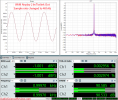LandscapeJohn
Member
- Joined
- Dec 7, 2022
- Messages
- 10
- Likes
- 14
I have a Rotel RC-1590 preamp and have noticed that when it's not muted there is an audible hiss from my tweeters. This prompted me to hook up my QuantAsylum 402 analyzer and measure the SNR to see what was up. The spec on the Rotel web page lists the 'IHF "A" Weighted' SNR for digital inputs at 108 dB. I haven't been able to measure a SNR above 90 dB using any setting I've tried so far.
Since I was primarily listening using the Bluetooth input my signal chain for testing was iPhone -> Bluetooth -> RC-1590 -> Balanced output -> QA-402. Playing a 1kHz test tone on the iPhone at max volume wouldn't yield more than around 70 dB SNR:

I switched to one of the optical inputs using a signal chain of iPhone -> AirPlay -> AppleTV -> Toslink -> RC-1590 -> Balanced Output -> QA-402. Playing the same 1kHz test tone on the iPhone at max volume yielded a much better SNR of around 87 dB but still nowhere close to the spec of 108 dB provided by Rotel.

The last screenshot shows a measurement with no signal playing and after the amplifier has gone into the standby "mute" feature after 10 or so seconds of no signal. This seems to me to rule out that the noise is being picked up someone after the Rotel in the measurement chain and also coincides with the hissing I hear from the tweeters that goes away once the mute relay clicks.

I've attached the settings file I used with the QA-402 but the highlights are:
RC-1590 Volume Setting: 65 (Around 66 the THD would start climbing (presumably overloading the input of the QA-402?) and much higher would result in the QA-402 trying to engage the input attenuator)
Sampling rate: 192k
Input Attenuator: 0
FFT: 256k
Averaging: 5
Weighting: A
Window: Hann
Since I was primarily listening using the Bluetooth input my signal chain for testing was iPhone -> Bluetooth -> RC-1590 -> Balanced output -> QA-402. Playing a 1kHz test tone on the iPhone at max volume wouldn't yield more than around 70 dB SNR:
I switched to one of the optical inputs using a signal chain of iPhone -> AirPlay -> AppleTV -> Toslink -> RC-1590 -> Balanced Output -> QA-402. Playing the same 1kHz test tone on the iPhone at max volume yielded a much better SNR of around 87 dB but still nowhere close to the spec of 108 dB provided by Rotel.
The last screenshot shows a measurement with no signal playing and after the amplifier has gone into the standby "mute" feature after 10 or so seconds of no signal. This seems to me to rule out that the noise is being picked up someone after the Rotel in the measurement chain and also coincides with the hissing I hear from the tweeters that goes away once the mute relay clicks.
I've attached the settings file I used with the QA-402 but the highlights are:
RC-1590 Volume Setting: 65 (Around 66 the THD would start climbing (presumably overloading the input of the QA-402?) and much higher would result in the QA-402 trying to engage the input attenuator)
Sampling rate: 192k
Input Attenuator: 0
FFT: 256k
Averaging: 5
Weighting: A
Window: Hann
